








A Brief History of Baie d'Urfé

 EARLY
TOWN HISTORY FROM 1686 TO 1700
EARLY
TOWN HISTORY FROM 1686 TO 1700
 THE
HISTORY OF SCOUTING IN BAIE D'URFE
THE
HISTORY OF SCOUTING IN BAIE D'URFE
The Town of
Baie d'Urfé is located in the west end of the Island of Montreal. The town is situated
beside a beautiful bay on the shores of Lake St. Louis, which extends into the St.
Lawrence River. The residential part of the town is bordered by Highway 20 on the
north, Lake St. Louis to the south, Beaconsfield on the east and Ste. Anne de Bellevue on
the west. There are about 3900 residents. The town is one of only two on the
island with large lots and a very quaint country-like atmosphere. The town is
covered with trees and has a number of scenic parks that access the waterfront. At
the same time the town is situated only a 20 minute drive from the beautiful metropolitan
city of Montreal. Montreal is the largest city in the Province of Quebec, and the
second largest city in Canada.

Montreal skyline looking south from Mount Royal
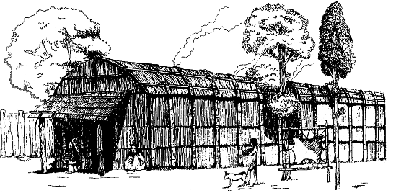
 For thousands of years the area
we live in was inhabited by our native tribes; primarily the Algonkin, Ojibawa and Iroquoian peoples. The Mohawk tribe, one of
six in the Iroquois Confederacy may have at many times camped on the shores of the bay, or
used the location as a base for hunting and fishing. The French, under Samuel de
Champlain explored the area in 1610 with a permanent settlement at Montreal in 1642.
For thousands of years the area
we live in was inhabited by our native tribes; primarily the Algonkin, Ojibawa and Iroquoian peoples. The Mohawk tribe, one of
six in the Iroquois Confederacy may have at many times camped on the shores of the bay, or
used the location as a base for hunting and fishing. The French, under Samuel de
Champlain explored the area in 1610 with a permanent settlement at Montreal in 1642.
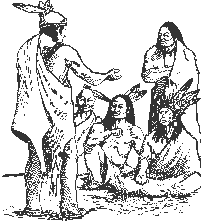 A man named Francois-Saturnin Lascaris
d'Urfé, founded a mission in the area later
to bear his name in 1686. d'Urfé cleared a spot for a remote outpost, planted his first
cross, built a church, parish house and several buildings, and brought together a number
of Iroquois, whom he taught and converted. The
early history of Baie d'Urfé is full of intrigue and interest. The
first
churchwarden was Jean De Lalonde.
He and four other habitants died in a battle with the Iroquois at Caron Point on September 30, 1687. In February 1704
a force of French and Abenakis Indians attacked Deerfield,
Massachusetts. Captives were lead back to New France. One captive,
Sarah Allen
became a domestic servant in a home in Baie D'Urfé in 1705 and a citizen of the
colony of New France in 1710. She married one of Jean's two sons, Guillaume in 1710
and had 13 children, 9 boys and 4 girls.
A man named Francois-Saturnin Lascaris
d'Urfé, founded a mission in the area later
to bear his name in 1686. d'Urfé cleared a spot for a remote outpost, planted his first
cross, built a church, parish house and several buildings, and brought together a number
of Iroquois, whom he taught and converted. The
early history of Baie d'Urfé is full of intrigue and interest. The
first
churchwarden was Jean De Lalonde.
He and four other habitants died in a battle with the Iroquois at Caron Point on September 30, 1687. In February 1704
a force of French and Abenakis Indians attacked Deerfield,
Massachusetts. Captives were lead back to New France. One captive,
Sarah Allen
became a domestic servant in a home in Baie D'Urfé in 1705 and a citizen of the
colony of New France in 1710. She married one of Jean's two sons, Guillaume in 1710
and had 13 children, 9 boys and 4 girls.
 The land for 250 years was used primarily
for farming, fishing and as a stop over point for fur traders going to and from Montreal
and up the Ottawa River. September of 1760 saw the fall of Montreal to the British, but
little changed for the residents, natives and clergy. In 1853 the railroad came to the
West Island with a local train stop in 1902. By the late 1800's the Baie had become a
popular recreational boating and centre. In 1907 MacDonald College of McGill University,
an Agricultural School opened in nearby Ste. Annes. English speaking residents started to
move in, the most well known included James Morgan, of the Henry Morgan & Company
Family (1909). The town of Baie d'Urfé was incorporated in 1911.
The land for 250 years was used primarily
for farming, fishing and as a stop over point for fur traders going to and from Montreal
and up the Ottawa River. September of 1760 saw the fall of Montreal to the British, but
little changed for the residents, natives and clergy. In 1853 the railroad came to the
West Island with a local train stop in 1902. By the late 1800's the Baie had become a
popular recreational boating and centre. In 1907 MacDonald College of McGill University,
an Agricultural School opened in nearby Ste. Annes. English speaking residents started to
move in, the most well known included James Morgan, of the Henry Morgan & Company
Family (1909). The town of Baie d'Urfé was incorporated in 1911.
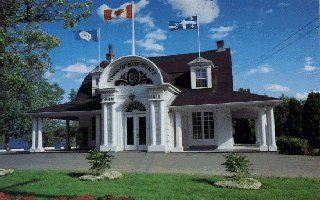
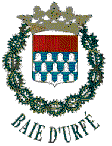
Baie D'Urfé Town Hall and Crest
 Around 1910 gentlemen farmers began to
bring a new way of life to the community, with some building large homes for summer fun
and entertaining. In 1915 electricity came to the town. Lakeshore Road, the main
access route to Montreal, was replaced by Highway 20 in 1940. After World War II,
the town grew radically - from 200 to 800 families in 10 years. Over the following
years the town built up the many services we enjoy today.
Around 1910 gentlemen farmers began to
bring a new way of life to the community, with some building large homes for summer fun
and entertaining. In 1915 electricity came to the town. Lakeshore Road, the main
access route to Montreal, was replaced by Highway 20 in 1940. After World War II,
the town grew radically - from 200 to 800 families in 10 years. Over the following
years the town built up the many services we enjoy today.





Birds in our town. Click on the bird to hear it's sound.
Baie d'Urfé has 10 parks, 3 schools
(English, French and German), one Day Care, one shopping centre and an industrial park.
Recreation services include clubs for swimming, tennis, yachting and curling.
Located in the centre of the town along Lakeshore Road are the renovated buildings we
affectionately know as the Red Barn and Coop. It is here that
the Beavers, Sparks, Cubs, Brownies, Scouts and Guides have their meetings.

Other views of the City of Montreal
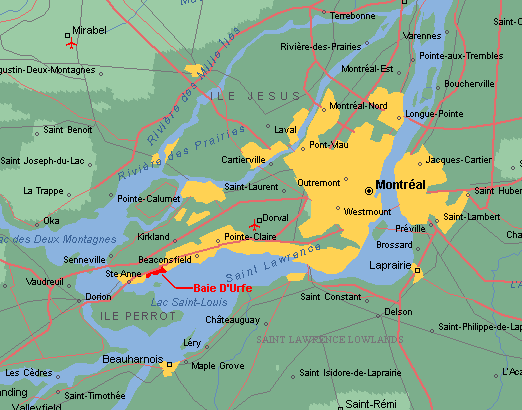
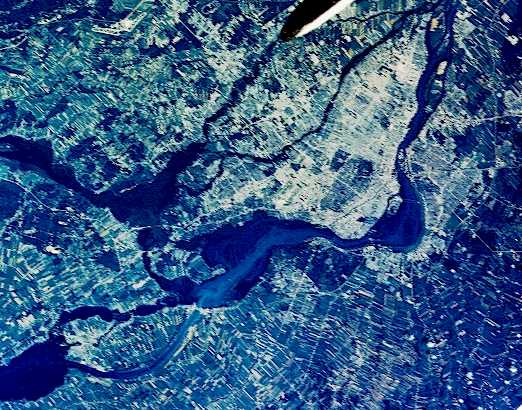
Image above taken by the NASA
Space Shuttle Discovery on Mission STS085 - 08-07-97
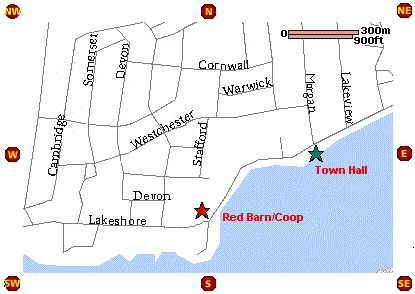
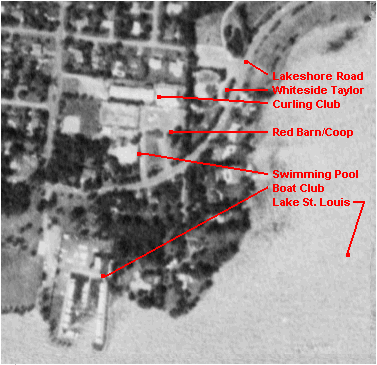
The above satellite photo was taken from SPIN-2 Sovinforumsputnik,
6:21PM GMT
30 June 1989, 214.6 km above Earth
Latitude 45.5378123900, Longitude -74.1062309400, Resolution 1.56 meters per pixel
To see photos of your pack's meeting place go to the Microsoft Terra Server
site

THE HISTORY
OF SCOUTING IN BAIE d'URFÉ
 On November 1st, 1953, the
Town Council granted a charter by the Canadian General Council of the Boy Scouts of Canada
Association to act as a sponsor for Scouting in Baie d'Urfé. In 1953 the Baie
d'Urfé Horticultural Society offered gardening instruction to the Cubs and Scouts, so
they could earn their gardening badge.
On November 1st, 1953, the
Town Council granted a charter by the Canadian General Council of the Boy Scouts of Canada
Association to act as a sponsor for Scouting in Baie d'Urfé. In 1953 the Baie
d'Urfé Horticultural Society offered gardening instruction to the Cubs and Scouts, so
they could earn their gardening badge.
The first meetings were held in the Town Hall but they quickly moved to the
Coop before moving to St. Georges is Ste
Annes. They were certainly in
St. Georges in 1960 as
David Moore was the Scout assistant to Jean Vauthier, the Akela at the time.
The Scouts continued at the Coop. The first Cubs used to meet with the Ste
Anne's pack in the basement of St.
Georges Church under Mr.
Stevenson. Mr. Stevenson was also the first leader of the Baie d'Urfe pack
until Reg Avey and George Lothian were qualified. The number at the start was
likely only 20 or so. (David Moore, East Sooke BC)
By 1957 there were 38 Cubs and 34 Scouts. In 1958 the organization grew
to 123 Cubs and 55 Scouts.
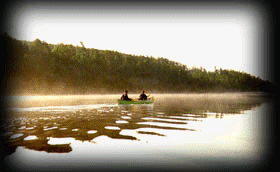
 The Chicken Coop was purchased soon after and
from then on became the centre of Scouting activity for residents. In 1963
membership had risen to 162 Cubs in Algonquin, Huron, Mohawk, Iroquois and Seeonee Packs,
and 52 Scouts in two troops. In 1971 there were 17 Venturers. In 1972 there
were 82 Cubs, 26 Scouts, 16 Venturers and 9 Rovers. In 1975 the Beaver programme started
and had 72 registered members. The Pack has always had the opportunity to utilize
Scouting facilities at Camp
Tamaracouta and Jackson Dodds in the Laurentian Mountains as well
as other facilities in the Morgan Arboretum, and the Arundel, Cap St. Jacques and Bois de
Liesse nature parks. During the Ice
Storm that ravaged the St. Lawrence river valley in early January 1998, and cut
electricity to the community for seven days, the Wolf Cubs helped out at the civic shelter
serving food and offering comfort.
The Chicken Coop was purchased soon after and
from then on became the centre of Scouting activity for residents. In 1963
membership had risen to 162 Cubs in Algonquin, Huron, Mohawk, Iroquois and Seeonee Packs,
and 52 Scouts in two troops. In 1971 there were 17 Venturers. In 1972 there
were 82 Cubs, 26 Scouts, 16 Venturers and 9 Rovers. In 1975 the Beaver programme started
and had 72 registered members. The Pack has always had the opportunity to utilize
Scouting facilities at Camp
Tamaracouta and Jackson Dodds in the Laurentian Mountains as well
as other facilities in the Morgan Arboretum, and the Arundel, Cap St. Jacques and Bois de
Liesse nature parks. During the Ice
Storm that ravaged the St. Lawrence river valley in early January 1998, and cut
electricity to the community for seven days, the Wolf Cubs helped out at the civic shelter
serving food and offering comfort.
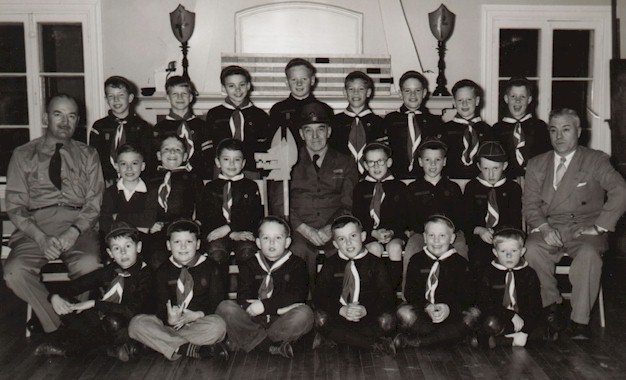
Earky picture taken in 1953 by Reg Vidler
at the Town Hall.
Back row: Trevor Kidmond (?), Stuart
Parker, John Brookhouse, Brian Marshall,
Ian Edwards, Hugh Avey, Stuart Proudfoot, David Moore.
Middle row: George Lothian, John Fenton, Jim Higman, Nick Kirton, Mr Stevenson,
Bruce Lothian, Craig Higman, ??, Reg Avey
Bottom row: Ted Wickstrom (?), David Belcher, Graham Ross, Jim DeWitt, Doug
Vanloan, David Brown(?)
16 of the Cubs above were from the Morgan-Lakeview-Sunny
Acres area (including the Lakeshore Road near those
streets). Marshall, Kirton and Vanloan
were from the very new Apple Hill-Willowdale-Oakridge
area. Leaders Lothian and Avey were from Sunny Acres.



October 04, 2004